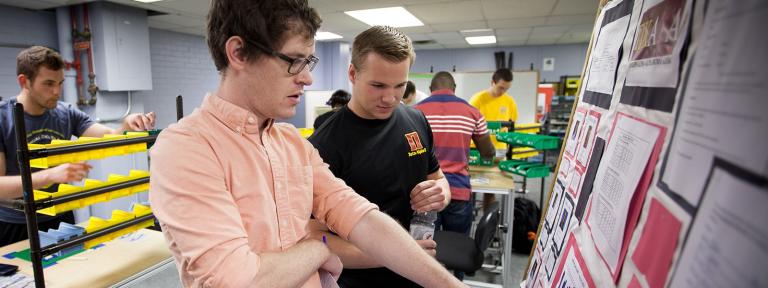
A big challenge for any college-level Manufacturing Engineering curriculum is to stay current with industry trends. Doing so requires institutions, especially those with world-class engineering programs such as Kettering, to update technological resources on a consistent basis. This also means that to address the constant demand for cost reduction in industry, organizations must implement time reduction strategies through automation and easy-to-learn software applications.
For Dr. Lucy King, professor of Manufacturing Engineering, the relationship developed between Kettering and Gibbs and Associates and CAM Logic several years ago with the help of the Partners for the Advancement of CAD Education (PACE). PACE is a partnership that has paid important dividends, particularly in recent months.
Gibbs and Associates produce GibbsCAM CAD/CAM technologies and software packages that make manufacturing work easier for companies throughout the world. For example, the company's GibbsCAM integrated offline CAM system and the Gibbs SFP embedded shop floor programming CAM system are fully compatible. This means that high level process models can be bi-directionally exchanged between the shop floor and manufacturing engineering.
The GibbsCAM resources will allow Kettering to streamline three courses: IME-409: Computer Integrated Manufacturing and IME-408: Automation with Robotics and CNC, both taught by King; and IME 403: Computer Numerical Control Machining taught by Dr. W.L. Scheller.
With these technological resources, students are now able to develop and create a CAD drawing and import it into the GibbsCAM software as an initial graphics exchange (IGS) file format. "After this step, the GibbsCAM software reads the drawing and with some operator input produces the computer codes required to work with the CNC equipment in the lab. The codes are then transferred to the manufacturing equipment through an Ethernet connection," she explained. She also added that this is particularly important because the codes are in theory "already simulated and verified within the GibbsCAM software, which helps to avoid manufacturing errors."
This means that it takes much less time to go from a simulated product on the computer screen to the real product, which could save companies a great deal of money during the manufacturing process. This is especially true in environments that rely on Internet manufacturing, where companies can engage the manufacturing process through the Internet and observe operations online. This software also provides for the customization of products quickly through computer connectivity. All of this helped create an integrated, more fluid, streamlined approach for IME-409, IME-408 and IME-403. Thus, the GibbsCAM software simultaneously performs many of the functions associated with these individual classes. As a result, GibbsCAM becomes a tool that facilitates the integration of multidisciplinary projects involving students enrolled in Mechanical Engineering, Electrical and Computer Engineering and Industrial Engineering capstone classes. This software helps these students from diverse majors bridge the functions of the design engineers and manufacturing engineers in the design, planning and the manufacturing of an electro-mechanical project.
This streamlined approach is critically important for students to experience since it closely emulates actual industry practices used by companies.
King is planning to host Gibbs and Associates and CAM Logic on campus on Friday, Oct. 27 to display how the GibbsCAM software works in the streamlining process. This may include bringing company officials to the Computer Integrated Manufacturing laboratory in the Academic Building, demonstrating the software on Kettering's Haas CNC machines and having participants use the resources. According to King, the software is very user-friendly and highly visual, thus allowing users to develop "a working knowledge of the software within a few hours time," she said.
King also said with the PACE grant presented to the University four years ago, Kettering received an introduction to a prior version of GibbsCAM for one year. Maintenance was approximately $7,500 per subsequent year for 50 seats. Due to budget issues, Kettering did not continue this contract. However, based on a recent agreement with Kettering ME Professor Paul Zang, King applied for a grant for 25 seats, which would save the institution $7,500 in the first year and $3,750 for each subsequent year for maintenance. The market value of this software is nearly $200,000.
"This contribution will save the University significant dollars while providing students with the chance to use the latest and greatest in manufacturing software," King said. She also said that this contribution helps in terms of supporting the Save Your Factories, an initiative sponsored by FANUC Robotics. Save Your Factories encourages manufacturers to fully and objectively analyze the advantages of technology, lean manufacturing and quality-enhancing techniques, process improvements, robotic automation, and the total cost of off-shore manufacturing before deciding whether to source overseas. This is of particular importance to Kettering students, since many of them will work with organizations and companies strongly considering exporting manufacturing-related positions overseas to reduce costs. But as many critics have stated, outsourcing of manufacturing jobs does not always mean a reduction in costs. In fact, a significant number of industry analysts have suggested over the last year that costs may increase due to many issues such as shipping and oversight expenses, quality, infrastructure and communication development costs among others.
King is currently undergoing in-depth training to fully comprehend and effectively use the new GibbsCAM software, and expects to incorporate it into the three classes for the fall 2006 term. She also plans on conducting a half-day demonstration for the Kettering community and the surrounding industrial community in the CIM lab using the new software as a means of recognizing Gibbs and Associates for their assistance. This demonstration, scheduled for the morning of Oct. 27, will be an interactive session in which participants would use the software to generate codes and streamline them into the Haas CNC machines in the lab. All are welcome to register.
To learn more about the GibbsCAM software and October workshop, contact Dr. Lucy King at (810) 762-7850 or Ian Scribner at (248) 969-9201.
Written by Gary J. Erwin
(810) 762-9538
gerwin@kettering.edu